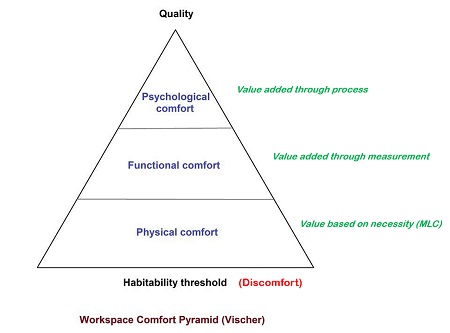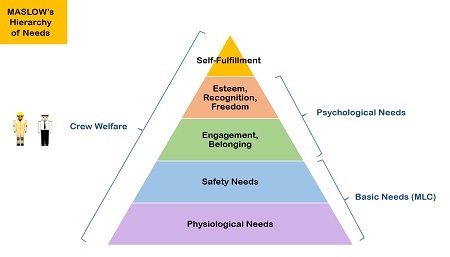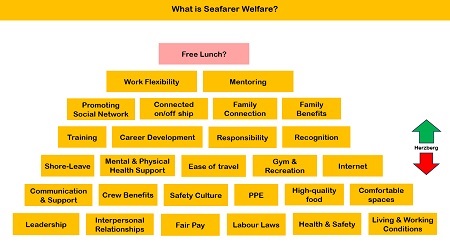TAKE CARE OF YOUR CREW AND THEY WILL TAKE CARE OF YOUR SHIP


This is an excerpt of my presentation at the Safety4Sea event in Limassol in January 2024.
Crewing is not just about putting people on board. It also means getting the most out of the people you are putting onboard; that you have engaged crew who are delivering their best for the ship. To have crew that is engaged and enthusiastic about giving their best onboard, ship operators need to invest in welfare.
Going beyond compliance: Welfare is a statutory procedure or social effort designed to promote the basic physical and material well-being of people in need. Employee welfare is a term that encompasses all the benefits and services that a given company offers its employees – regardless of their regular salary – to appreciate their daily work and take care of their well-being. When it comes to shipping, things have improved a lot during the last few years, however, more actions are needed. This article suggests a more holistic approach towards crew welfare, going beyond the minimum requirements of the Maritime Labour Convention.


Crew Accommodation: You can have cabins and washrooms which tick a box but then do ask your crew if the cabins provide sufficient comfort to get recharged for the next day of work. The below model (Vischer et al) describes how habitability can be improved to enable seafarers to perform at their optimal levels.
Poor welfare is often tolerated but never rewarded: Often seafarers start their contracts onboard with certain financial targets in mind. Even when faced with poor accommodation or food, they may endure it silently, propelled by the necessity to meet their financial responsibilities. However, a seafarer who is unable to rest or feel positive is not always able to give his best at work. Also, when seafarers perceive a lack of care for their welfare, they may move to other companies when presented with an opportunity to do so.
Nevertheless, according to Marslow’s Hierarchy needs, seafarers have both basic and psychological needs, requiring ship operators’ awareness to provide all proper conditions to fulfil their needs and ensure their welfare.

Different crews have different needs: At the very minimum, comfortable accommodation, and tasty and nutritious food is required. But seafarers also need a sense of community and empowerment as Maslow’s Hierarchy of Needs would also tell us. If seafarers feel that ship owners do not fulfil their various needs, they tend to be less engaged. Less engagement results in lower productivity and lower retention. In general, when someone shows up at the workplace despite having low motivation, this is called presenteeism – physically present but not necessarily mentally in the zone. This has a negative consequence for the working environment.
Crew engagement is the degree to which the seafarer feels committed to an organization, identifies with an organization, feels satisfied with their job and feels energized at work. According to a survey by the Harvard Business Review, crew engagement can result in 22% higher productivity, 60% increased retention, 45% reduction in incidents and 41% improved quality.
Steps for sustaining and improving engagement: Engagement can vary over time, and the following could be considered:
Basic Needs, as defined by the Maritime Labour Convention
- Physiological Needs – Psychological and Functional Comfort
- Psychological Needs –Communication, Feedback, Career Development
- Work Tools and Training
- Leadership skills- Managers account for over 70% of the variance in employee engagement
- Listen and communicate – Effective internal communications can motivate 85% of employees to become more engaged
- Reward & accountability – 69% of employees say they’d work harder if they were better appreciated
- Engagement Surveys – 58% of employees wish their company measured employee engagement more frequently
- (Safety) Culture
- Crew Welfare initiatives
The ‘last mile’ delivery of welfare programs: Regardless of the number of welfare programs run by a company, without effective leadership, these efforts will fail to serve their intended purpose. Poor leadership and interpersonal conflicts can undo even the best corporate welfare programs. In that regard, I would advise ship operators to view welfare from a holistic perspective and invest in leadership and training.
Listing seafarer welfare initiatives: The below diagram is a non-exhaustive list of crew welfare initiatives. Those at the bottom are the basic minimum and the ones on the higher levels increase value, inspired by Herzberg’s factors of motivation. More initiatives strategically implemented result in higher engagement.
Of course, there’s no ‘free lunch’; crew welfare is not about removing accountability for work results.
Internet and mental health: With regards to crew connectivity, the largest number of calls are due to family matters. Data from a mental health hotline have demonstrated that frequent reasons that affect seafarers are: aggression; anxiety & depression (symptoms: insomnia, forgetfulness); bullying and; stress (burnout). Thus, it is vital to ensure seafarers have access to the internet and mental health hotlines for support.
From the leadership point of view today, organizations that do not pay sufficient attention to people and the deep sentiments and relationships connecting them are consistently less successful than those that do.

Call to Action: Finally, I would recommend that crew welfare is thought of with the below five high-level points:
Holistic Crew Welfare Program
- Dedicated persons for crew welfare
- Measure crew engagement
- Close communication
- Leadership skills
The full video can be found here:


